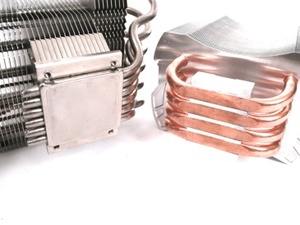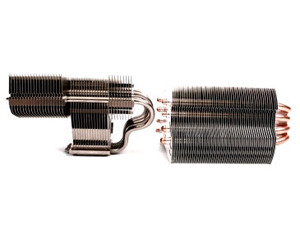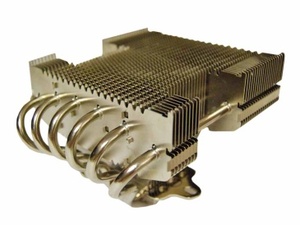Noctua NH-C12P CPU Cooler Review
July 1, 2009 | 10:14
Companies: #amd #intel #noctua #test #thermalright

The Heatsink
Even with similar looking heatsinks, we've seen some subtle differences between every CPU cooler we've tested. The NH-C12P however isn't your standard tower shaped heatsink. Instead the six heapipes bend 90 degrees from the contact plate with the heatsink fins directly attached to the baseplate in a top down configuration, while the fan directs airflow through the fins and onto the motherboard below.This has its advantages and disadvantages. It provides exceptional cooling to the CPU socket area so your VRMs and chipset/Northbridge can take advantage of this local airflow (motherboards have the VRM and chipset heatsinks facing the CPU socket deliberately to take advantage of this) and usually end up a fair bit cooler than using a vertical heatsink such as the Titan Fenrir.
The downside is that the warm air is simply spilled into the case rather than being directed to the rear for extraction. In many cases there a rear fan mount level with the CPU socket, so these two can work very well in tandem. Unfortunately things won't be quite as efficient with the NH-C12P but so long as you have good airflow, it shouldn't be a problem, and after all, your motherboard will likely be cooler too.
The six heatpipes pass through the contact plate but don't make direct contact with the CPU IHS (above we can see the NH-C12P and Titan Fenrir side by side). This can be a good thing because if they did it can be a very hit and miss affair with oodles of thermal paste usually needed to fill in the gaps between the contact plate and the heatpipes. Not so here. The contact plate sandwiches the heatpipes between it and is the only thing in direct contact with the CPU. On the downside, this means heat transfer to the heatpipes won't be quite as efficient though.
The fins are quite widely spaced compared to other CPU coolers we've seen - with gaps at roughly eight per inch - which turns out to be practically the same as the Titan Fenrir, although the latter's are deeper. This should mean that the NH-C12P should perform well at low fan speeds. However, there's much less fin surface area available compared to the Fenrir, so this will probably mean it won't perform quite as well, especially under load. Unfortunately the heatpipes protruding out the end of the contact plate aren't crimped in a particularly attractive way but you won't be able to see them once it's installed anyway. Apart from this minor point, the NH-C12P oozes quality all over.
The base and heatpipes are made of nickel plated copper, while the fins are aluminium. This combination is generally regarded as optimal as copper is good at conducting and holding heat but not as optimal as aluminium at expending it into the air. Nickel plating also protects the copper from tarnishing and the natural acidic oils from fingerprints. The central section of fins is attached directly to the contact plate while the rest rely on the heatpipes for their heat.

MSI MPG Velox 100R Chassis Review
October 14 2021 | 15:04
















Want to comment? Please log in.